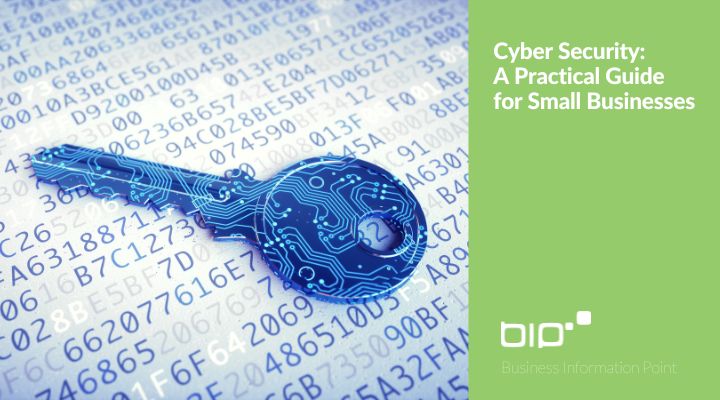Cyber Security Guide for Small Businesses

The cyber attack on Marks & Spencer in the first half of 2025 wreaked havoc — slashing statutory profits before tax by 99%, halting online orders for months, and leaving shelves bare. While M&S’s size and reputation helped it recover, smaller businesses rarely have that safety net.
Cyber attacks aren't just a big business problem. To the sole traders, the self-employed professionals, and the small business owners — no matter your size, your digital assets are just as valuable to cyber criminals. In fact, according to the Federation of Small Businesses, nearly half of the UK’s small businesses could face a cyber attack, costing an average of £1,400 each time. It's time to protect what you’ve worked so hard to build – starting now. Here's how.
Engage your employees as your first line of defence
Your employees can be your biggest vulnerability — or your strongest defence. Most cyber attacks begin with human error: a misplaced click, a weak password, or a phishing email. The good news? Awareness and training can reduce those risks dramatically.
- Start with short, practical sessions. A 20-minute workshop on how to spot suspicious emails can make a big difference.
- Promote a no-blame culture. If an employee makes a mistake or spots something suspicious, they need to feel safe reporting it quickly.
- Embed cyber awareness into everyday practice. Treat security like health and safety — part of how your business runs, not an afterthought.
When your team knows what to look for and how to respond, they become active partners in safeguarding your business.
Data protection strengthens your business
Protecting data isn’t just about compliance — it’s good business. Strong data management builds customer trust, prevents fraud, and creates smoother internal processes.
- Keep customer data safe. Use secure systems for storing personal or payment details, and encrypt files where possible.
- Review who has access. Limit access to sensitive data to only those who need it for their job.
- Stay compliant. Following GDPR guidelines isn’t optional, but it’s easier than you might think — more on that below.
When customers trust that their data is handled responsibly, they’re more likely to stick with you.

What does a cyber security plan look like?
With so many digital tools — from cloud storage to online payments — a clear cyber resilience plan is essential. It’s not just about technology; it’s about protecting your business, your reputation, and your ability to operate when things go wrong.
Cyber resilience isn’t just a defensive measure — it’s a competitive advantage. Businesses that can recover quickly from disruption earn trust and stability in a world where attacks are inevitable.
Here’s what an effective cyber security framework includes:
Regular staff training
Human error is the biggest risk. Train everyone — from part-timers to directors — on how to spot phishing attempts, suspicious attachments, and fake login screens.
Quick win: Schedule short, regular refresher sessions once or twice a year, or use free online resources from the National Cyber Security Centre (NCSC). Make it engaging – not just an online test they have to whizz through and ‘pass’. Use real-world examples and get everyone thinking about how a similar example could affect the business.
Protect your critical systems
Start by mapping out your business systems — website, payment software, email, customer database. Which ones are essential to operations? Focus protection there first.
- Use firewalls and antivirus software on all devices
- Keep software and operating systems updated automatically
- Review suppliers and cloud services for their own security measures.
Separate critical and non-critical systems
Don’t keep everything connected. Segmenting your systems ensures a breach in one area doesn’t compromise the rest of your network.
Example: Keep your accounting software and customer database separate from your marketing tools or staff chat apps.
Restrict access
Only give people access to the systems and data they genuinely need. It’s not about mistrust — it’s about reducing risk.
Quick win: Review admin privileges. If everyone’s an admin, you’ve got a problem.

Segment your network
Not everyone who connects to your systems — from employees to contractors and suppliers — needs full access. Use network segmentation to ensure people only reach what’s relevant to them. This prevents a breach from spreading through the entire system.
Practise your response
Don’t wait until you’re under attack to test your plan. A quick tabletop exercise every 6–12 months can help everyone understand their role and expose gaps in your process.
Review regularly
Cyber threats evolve quickly. What protected you last year may not be enough today. Review your policies and training regularly, especially after system updates, staff changes, or new tools are introduced.
If people are skipping security steps, don’t assume they’re careless — the process might need simplifying.
Have an incident response plan
Think of this as your fire drill for digital emergencies. A good plan outlines:
- Who to contact if a breach occurs
- How to isolate affected systems
- How to communicate with customers and partners
- How to recover and rebuild
Businesses that plan ahead recover faster — and retain more trust.

Quick wins you can put into action today
Building cyber resilience doesn’t mean an overnight overhaul. Start small — consistency is key. Here’s what you can do this month:
- Run a short session to help staff spot phishing emails
- Review who has administrative access — restrict it where possible
- Check your data backups and test them
- Turn on multi-factor authentication for all key systems
- Schedule a 30-minute meeting to review your incident response plan.
Each of these steps takes less than an hour but can save you thousands in the event of an attack. Remember: progress, not perfection, is the goal.
A word on GDPR
GDPR (General Data Protection Regulation) is about protecting personal data — yours, your employees’, and your customers’. For small businesses, compliance can seem daunting, but it mostly boils down to three principles:
- Collect only what you need. Don’t hold unnecessary data.
- Store it securely. Use encrypted, password-protected systems.
- Be transparent. Let people know how and why you use their data.
If you handle customer information — even an email address — GDPR applies. Following its principles also helps build credibility and reduce the risk of fines or reputational damage. The Information Commissioner’s Office (ICO) has a web page with lots of helpful information and advice specifically for small businesses.

Cyber attacks can feel abstract — until they happen. But protecting your small business doesn’t have to be complicated or expensive.
By taking small, steady steps — training your team, limiting access, testing backups — you’re building resilience that safeguards everything you’ve worked for.
In a world where cyber attacks are becoming the norm, being prepared isn’t just smart — it’s good business.

Share this Post
